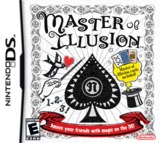a GOOD game worths played!
Master of Illusion is also a tough product to review. It's less of a game in the traditional sense than most of Nintendo's other Touch Generation products. This is a tutorial on how to perform magic tricks, and to review the game means to talk about the tricks, ruining the enjoyment and idea of the product. There's a general "magician's code" and the problem of revealing what the tricks are and how they're done. So to honor the code (and to not spoil the enjoyment for others) you won't find any secrets revealed nor will you find any allusions to how the illusions are performed.
The package is divided into three sections: Solo Magic, Performance, and Practice. Solo magic is tricks that the system performs on anyone that picks up the system; the Nintendo DS becomes the master illusionist. These are tricks in the "mathematical" design or in visual illusions that might take one or two attempts to see the "trick" behind the trick. These are meant for the critical mass – once you've performed the Solo Magic on yourself or someone else, you need to move onto the next rube or it's a wasted effort.
In the performance section, these are tricks that you perform on other people using the Nintendo DS. Some require touch screen interactivity by the person you're performing to, but mostly you have to remain in control or the tricks will never work. In the Master of Illusion pack you get a set of playing cards that are used in many of the performance tricks. Clearly there's a reason why the game gives away a deck of cards…and it's a damn fine deck of cards to use, and works well with the Master of Illusion tricks. The tricks are pretty amateurish, naturally. These aren't David Blaine spectacles…these are barely even Harry Blackstone or Doug Henning performances. But they're perfect for the younger crowd to wow their friends or parents with their skills of illusion.
The way the tricks are explained is through still screens and artwork. You get the basic idea of the performance, but the whole idea of finesse and showmanship has to come from the player. Any poor performance can easily reveal how the tricks are done, so a lot of the "issues" of Master of Illusion isn't so much the package's problems, but of who does the tricks. But the game could have certainly done a better job demonstrating how the tricks could be performed…maybe through short video clips of someone who knows what they're doing.
The "practice" portion to strengthen your magic skills is as much of a stretch as the claim that Vision Training makes your eyeballs stronger. But these "practices" are cool Brain Age-style tasks, like trying to write a letter of the alphabet in a mirror image on the lower screen.
Actually, a lot of Master of Illusion is based around the Brain Age mentality: you can only open up so many portions of the product each day, based on the system clock. So unless you do the time travel thing and advance the internal date of the Nintendo DS, you'll spend quite a few days opening up all the tricks and treats of the package.

